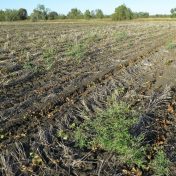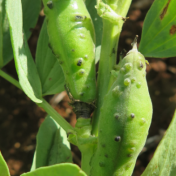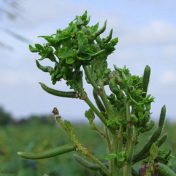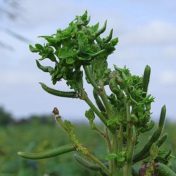From this winter, the Beatsheet will start expanding to incorporate information on broadacre crop diseases (including alerts, identification and management). Recent alerts have been issued to watch for the diseases below: Ascochyta blight – reported in chickpeas in the eastern Downs Cereal rust – reported from southern Queensland and northern New South Wales. Bean yellow mosaic virus – detected in… Read more »
Key points: There was a resurgence in tobacco streak virus (TSV) disease in mungbeans in early 2020 TSV is restricted to central QLD and closely related to the distribution of parthenium weed Growers are encouraged to avoid areas of dense parthenium to reduce risk In autumn of 2020, tobacco streak virus (TSV) was found to be common in all mungbean… Read more »
Several growers and agronomists across southern Queensland have reported extensive damage to their mungbean crops due to Fusarium wilt this season. Large areas of affected paddocks have plants that are wilted or dead, resulting in significant yield losses. The results of DAF annual disease surveys over the last five years have found that the disease is most common in crops… Read more »
Since early March 2020, soybean growers in the Burdekin have seen significant damage to their crops. Close inspection of crops found many with soybean stem fly damage as well as leaf spots, and stem and pod lesions. Severely affected plants have suffered complete and rapid leaf defoliation. In many crops, plants did not collapse until the late pod-fill stage, when… Read more »
Recent rainfall has led to opportunistic late plantings in some areas. The current high relative humidity may also lead to an increased risk of disease in some crops. Department of Agriculture and Fisheries (DAF) plant pathologists are encouraging Northern Region grain growers to submit disease samples (particularly powdery mildew in mungbeans) for diagnosis as part of effective paddock monitoring and… Read more »
In 2019, many of the faba bean crops have growths on pods. There has been much debate over the years about the cause/s of the lumps seen on the pods of faba beans; with some attributing it to thrips, or more recently to green mirid feeding. The growths are called oedema or intumescences, and are caused when the uptake of… Read more »
Phytoplama has been reported in second flower flushes in mungbeans, and also in harvested mungbean regrowth! So far the overall incidence of phytoplasma has been lower than this time last year, but growers and consultants are urged to keep monitoring their crops for the first symptoms of this disease, and to report any outbreaks. Many January-planted mungbean crops are at… Read more »
UPDATE: Crop progress report (March 2018) Recent photos of the crop where a stem fly infestation was reported in early February show signs of stem fly pupation, but no crop stress symptoms (i.e. no yellow and dying leaves), indicating that managing the outbreak when it was first detected would have been a waste of time and money (assuming there will… Read more »
Last summer saw unprecedented levels of phytoplasma in summer pulses/legumes (including chickpeas, mungbeans and pigeon peas) in all cropping regions in eastern and northern Australia from the Ord Irrigation area (WA), Burdekin/Atherton Tablelands (NQ), to central NSW. The most likely insect vector is the brown leafhopper Orosius orientalis, which has been detected in recent (2017) spring crops. While plantings of… Read more »
Phytoplasma (a specialised bacteria infecting plants) has been widely reported in spring-planted mungbeans from Central Queensland to North Western NSW (Moree and Narrabri) and all areas in between. Symptoms include masses of small deformed leaves, flowers and pods, plants remaining green at harvest, and possibly an increased incidence of puffy pod. While in previous recent summers, moderate to high levels… Read more »










